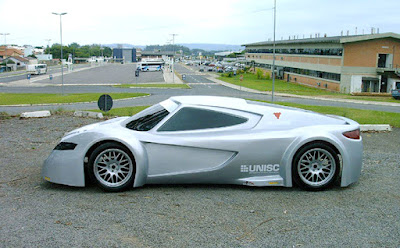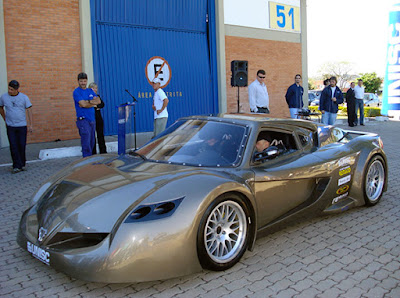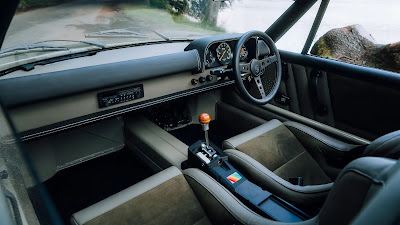Forgotten ONES - In the vibrant and diverse world of automotive manufacturing, Brazil is a name that often escapes the limelight. However, this South American giant holds a significant place in the industry, thanks to its unique and innovative domestic producers. Among the many automotive marvels that Brazil has given birth to, one particularly stands out—the Madom GT, a sports car that first emerged in the early 2000s, capturing attention with its striking design and robust performance.
 |
| Prototype of the Madom GT body, still without mechanical components. (Picture from: LexicarBrasil) |
The story of the Madom GT begins with Maurício Domingues, a passionate driver from Rio Grande do Sul. In 2003, driven by his love for racing and innovative spirit, Maurício embarked on a journey to create a sports car that would leave a lasting mark. The car's design was entrusted to the capable hands of Spanish designers Oscar Ortiz, affiliated with Audi, and Sergio de la Fuente from Airbus. Their combined expertise and Maurício's vision set the stage for the birth of an extraordinary vehicle.
 |
| The rolling model of the Madom R/T prototype without an engine. (Picture from: LexicarBrasil) |
Maurício’s adventures in karting competitions across Spain honed his skills and deepened his understanding of automotive engineering. Upon his return to Brazil in 2005, he was determined to turn his dream into reality. With a dedicated team of professors and students from the University of Santa Cruz do Sul (RS), Maurício began the meticulous process of building the prototype. This collaborative effort led to the creation of a 1:5 scale model, where every detail was scrutinized and perfected.
 |
| Prototype of the Madom R/T exhibited in 2008 at the University of Santa Cruz do Sul. (Picture from: LexicarBrasil) |
The culmination of their hard work came in 2008 with the completion of the first Madom GT prototype. This remarkable sports car featured a tubular chassis and a sleek, fiberglass-reinforced plastic body. The innovative design included doors that hinged at the front pillars and opened upwards, adding to the car’s futuristic appeal. At the heart of the Madom GT was a powerful 3.0-liter V6 engine sourced from a Chevrolet Omega, delivering an impressive 210 horsepower. The engine was mounted in the rear, complemented by four-wheel independent suspension and FIA-standard disc brakes, ensuring top-notch performance and safety.
 |
| Prototype of the Madom R/T exhibited in 2008 at the University of Santa Cruz do Sul. (Picture from: LexicarBrasil) |
Maurício's vision for the Madom GT was not limited to a single model. He planned two versions of the car to cater to different driving experiences. The R/T, standing for Road & Track, was intended for both city driving and competitive racing. The city version boasted a V6 engine fine-tuned to produce 300 horsepower, while the competition variant aimed for a staggering 700 horsepower with a V8 engine. By 2010, three prototypes had been built, each a testament to Brazilian ingenuity and engineering prowess.
 |
| Prototype of the Madom R/T during its first test at the Autodrome Internacional de Santa Cruz do Sul. (Picture from: LexicarBrasil) |
The journey of the Madom GT is a compelling narrative of passion, collaboration, and innovation. It exemplifies how Brazil, often overshadowed in the global automotive arena, can produce exceptional vehicles that compete on the world stage. The Madom GT not only highlights the country's potential in automotive manufacturing but also serves as an inspiration for future generations of designers and engineers. Due to the absence of video about this sports car, here is a video about the Brazilian Ford Maverick GT with a 5.0! The Mustangs little brother! Awesome muscle car!;
 The legacy of the Madom GT continues to resonate, reminding us that remarkable creations can come from unexpected places. As we look to the future, the story of the Madom GT encourages us to appreciate the ingenuity and dedication that drive the automotive industry forward. Brazil's contribution to this field is undeniable, and the Madom GT is a shining example of what can be achieved with vision and determination. *** [EKA | FROM VARIOUS SOURCES | LEXICARBRASIL | ALLCARINDEX ]
The legacy of the Madom GT continues to resonate, reminding us that remarkable creations can come from unexpected places. As we look to the future, the story of the Madom GT encourages us to appreciate the ingenuity and dedication that drive the automotive industry forward. Brazil's contribution to this field is undeniable, and the Madom GT is a shining example of what can be achieved with vision and determination. *** [EKA | FROM VARIOUS SOURCES | LEXICARBRASIL | ALLCARINDEX ]Note: This blog can be accessed via your smart phone







































